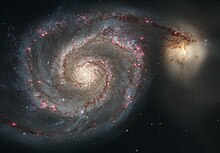Whirlpool galaxy
| Whirlpool galaxy | |
|---|---|
 | |
| Observation data (J2000 epoch) | |
| Constellation | Canes Venatici[1] |
| Right ascension | 13h 29m 52.7s[2] |
| Declination | +47° 11′ 43″[2] |
| Redshift | 463 ± 3 km/s[2] |
| Distance | 23 ± 4 Mly (7.1 ± 1.2 Mpc)[3][4] |
| Apparent magnitude (V) | 8.4[5] |
| Characteristics | |
| Type | SA(s)bc pec[2] |
| Size | ~60,000ly in diameter[6] |
| Apparent size (V) | 11′.2 × 6′.9[2] |
| Notable features | Interacting with NGC 5195[7] |
| Other designations | |
| Question Mark Galaxy,[2] Rosse's Galaxy,[2] M51a,[2] NGC 5194,[2] UGC 8493,[2] PGC 47404,[2] VV 001a,[2] VV 403,[2] Arp 85,[2] GC 3572[2] | |
The Whirlpool galaxy, is also known as Messier 51a, M51a, or NGC 5194. It is a large galaxy with well-defined spiral arms, with a smaller companion galaxy. They have been through a collision,[8] and are still interacting.[7]
The Whirlpool was the first galaxy to be classified as a spiral galaxy.[9] Different methods put its distance as between 15 to 35 million light-years. Recently it was estimated to be 23 ± 4 million light-years from the Milky Way.[3] Messier 51 is one of the best known galaxies in the sky.[10]
Its spiral arms are so impressive and well-defined that it is called a "grand design" spiral galaxy.[11] It has an active galactic nucleus,[12] no doubt fuelled by a massive black hole.
The galaxy and its companion, NGC 5195, are easily seen by amateur astronomers, in the constellation Canes Venatici. The two galaxies can be seen with binoculars.[13] The Whirlpool galaxy is also a popular target for professional astronomers. They study its galaxy structure (particularly the spiral arms) and galaxy interactions.
References[change | change source]
- ↑
Dreyer J.L.E. 1988 (1988). In Sinnott R.W (ed.). The Complete New General Catalogue and Index Catalogue of Nebulae and Star Clusters. Sky Publishing Corporation/Cambridge University Press. ISBN 0-933346-51-4.
{{cite book}}: CS1 maint: numeric names: authors list (link) - ↑ 2.00 2.01 2.02 2.03 2.04 2.05 2.06 2.07 2.08 2.09 2.10 2.11 2.12 2.13 2.14 "NASA/IPAC Extragalactic Database". Results for NGC 5194. Retrieved 2006-12-06.
- ↑ 3.0 3.1
Takáts K. & Vinkó J. 2006. (2006). "Distance estimate and progenitor characteristics of SN 2005cs in M51". Monthly Notices of the Royal Astronomical Society. 372 (4): 1735–1740. arXiv:astro-ph/0608430. Bibcode:2006MNRAS.372.1735T. doi:10.1111/j.1365-2966.2006.10974.x. S2CID 18062981.
{{cite journal}}: CS1 maint: numeric names: authors list (link) - ↑ "Distance Results for MESSIER 051". NASA/IPAC Extragalactic Database. Retrieved 2011-06-06.
- ↑ "M51". SEDS.org.
- ↑ http://www.nasa.gov/multimedia/imagegallery/image_feature_2457.html#.VIX_OGf0DDE Retrieved Dec-2014
- ↑ 7.0 7.1 Arp H. 1966 Atlas of peculiar galaxies. Astrophysical Journal Supplement 14, 1–20. [1]
- ↑ When galaxies collide, they actually move through each other. This causes gravitational effects, and leads to an increase in star formation.
- ↑ "Whirlpool Galaxy: First Spiral Galaxy". Universe for Facts. Archived from the original on 17 December 2014. Retrieved 21 December 2014.
- ↑
Scalzi, John 2003. (2003). The Rough Guide to the Universe. Rough Guides. pp. 250. ISBN 1-85828-939-4.
{{cite book}}: CS1 maint: numeric names: authors list (link) - ↑
Elmegreen D.M. & Elmegreen B.G. 1987 (1987). "Arm classifications for spiral galaxies". Astrophysical Journal. 314: 3–9. Bibcode:1987ApJ...314....3E. doi:10.1086/165034.
{{cite journal}}: CS1 maint: numeric names: authors list (link) - ↑ Matsushita, Satoki; Muller, Sebastien & Lim, Jeremy 2007 (2007). "Jet-disturbed molecular gas near the Seyfert 2 nucleus in M51". Astronomy & Astrophysics. 468 (A&A Letters Special Issue): L49–L52. arXiv:0704.0947. Bibcode:2007A&A...468L..49M. doi:10.1051/0004-6361:20067039. S2CID 15471799.
{{cite journal}}: CS1 maint: multiple names: authors list (link) CS1 maint: numeric names: authors list (link) - ↑ Nemiroff, Robert & Bonnell, Jerry 2000. "M51: The Whirlpool Galaxy". Astronomy Picture of the Day. NASA. Retrieved 2007-04-22.
{{cite web}}: CS1 maint: multiple names: authors list (link) CS1 maint: numeric names: authors list (link)
